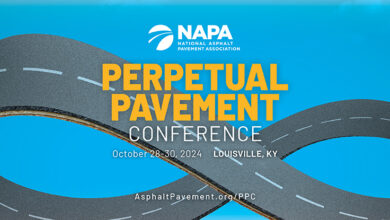Perpetual Pavement Conference session to examine 23 years of research at NCAT
Buzz Powell, NCAT’s original Test Track manager, will present findings during Oct. 28-30 conference in Louisville, Kentucky.
By Ty Johnson
Editorial Director
When it comes to Perpetual Pavements, the Test Track at Auburn University has quite the track record.
The asphalt proving grounds at the National Center for Asphalt Technology (NCAT) have been operating since 2000, meaning the Test Track has been chronicling pavement performance for more than two decades. Nearly all of those 23 years of research came under the direction of former NCAT Associate Director Buzz Powell, who joined the staff at the Asphalt Pavement Alliance (APA) in 2024 as the organization’s first technical director.
Powell examines the Test Track’s eight research cycles so far in “A Historical Overview of the Diverse Perpetual Pavements on the NCAT Pavement Test Track,” a white paper he’ll present on at the 2024 Perpetual Pavement Conference in Louisville, Kentucky Oct. 28-30.

Powell said his paper doesn’t focus solely on examples or situations where perpetual pavements were used, but instead promotes the idea that there’s a spectrum.
“There’s a lot of ways to do perpetual pavements and so that paper doesn’t do a deep dive on any one of them,” he said. “It just provides an overview of all the different ways and aims to make people aware of what the possibilities are.”
Powell said while the late Dave Newcomb is credited as the “father of perpetual pavements,” the approach is built on strain theory that can be traced back to Carl Monismith’s research at California-Berkeley in the 1960s. His paper takes a closer look at long-lasting pavements at the NCAT Test Track and the different ways researchers have constructed perpetual pavements.
“With perpetual pavements, when you have good materials, good designs, and good construction they never have to be salvaged. They never have to be rebuilt,” Powell said. “And if you time your interventions correctly, you can stay really shallow on the surface and never have to do anything any deeper than thin, surface-type stuff because the foundation literally lasts forever.”

Powell said while perpetual pavement programming suggests roads can last 50 years, he often talks about how there is no time limit, if conditions are right. He said he mentioned that during a webinar on long-lasting pavements over the summer and it predictably led to a question on pavement thickness.
“The reason why I wrote the paper is we instinctively think about just pavement thickness, and I encourage people to think outside the box. The easy way to do perpetual is just to look at the supporting material and get a thickness that gets the strain level low enough so it never cracks,” he said. “So there is a short answer and an easy way to do a perpetual pavement, and that’s just to build a really thick pavement, but the secret sauce is to be a good engineer and find a way to do it at the lowest possible cost and at the highest speed of construction.”
The first Test Track in 2001 was built using empirical design methodology, Powell said, meaning the computer suggested that to survive a half-dozen research cycles of 10 million equivalent single-axle loadings (ESLs), the pavements needed to be two feet thick.
“The original track was very, very thick,” Powell said, explaining that more than a foot of materials were superfluous in retrospect. “It was an insurance policy, but it was unnecessary. Nine inches was perpetual. We found out later that less than six inches could be perpetual with the right kind of innovative materials in the buildup. That’s what sold me on the idea on the need for moving from empirical pavement designs, which have no perpetual lever or button you can push, to mechanistic empirical designs.”
While some of the earliest perpetual pavements at the Test Track relied on thickness, Powell pointed out that in some cases there was as much as 15 inches of wasted material beneath perpetual pavements that came in at nine inches.

“If you think about that, if a state department of transportation wants to build a perpetual pavement, and you go from 24 inches to 9 inches, you can build almost three jobs for the cost of one,” Powell explained.
Powell said those results from the Test Track’s early days show how far the industry has come and how the NCAT facilities have been helping innovate the industry from its beginning.
“It’s a good illustration of why we why we need to change the old way of doing things and adopt the newer methods and mechanistic empirical methods that really drive perpetual pavement design and performance,” he said.
Powell said he hopes his paper helps showcase all the creative tools that engineers now have in the toolbox to efficiently design and build perpetual pavements. He also said he hopes it helps illustrate how many different ways pavements can achieve long-lasting performance.
“We’ve done that at the Test Track on different types of pavement structures, with really unique features that have proven perpetual performance,” he said.
Powell said he attended the first Perpetual Pavement Conference in 2004, when the trend was to pave thick enough to manage surface stresses and to ensure the pavement won’t crack from the bottom up. He said engineering has evolved since that inaugural conference, when the focus was getting buy-in on basic principles, and this year’s edition will have something for transportation officials, engineers, and members of academia.
“I’m excited about the conference because not only are we trying to promote the idea of making smarter investments in pavement, but also the innovations,” he said. “Now it’s about the engineering that we can put into the different parts of that pavement structure so that we can design and build them more efficiently and take advantage of the innovations that are out there.”



